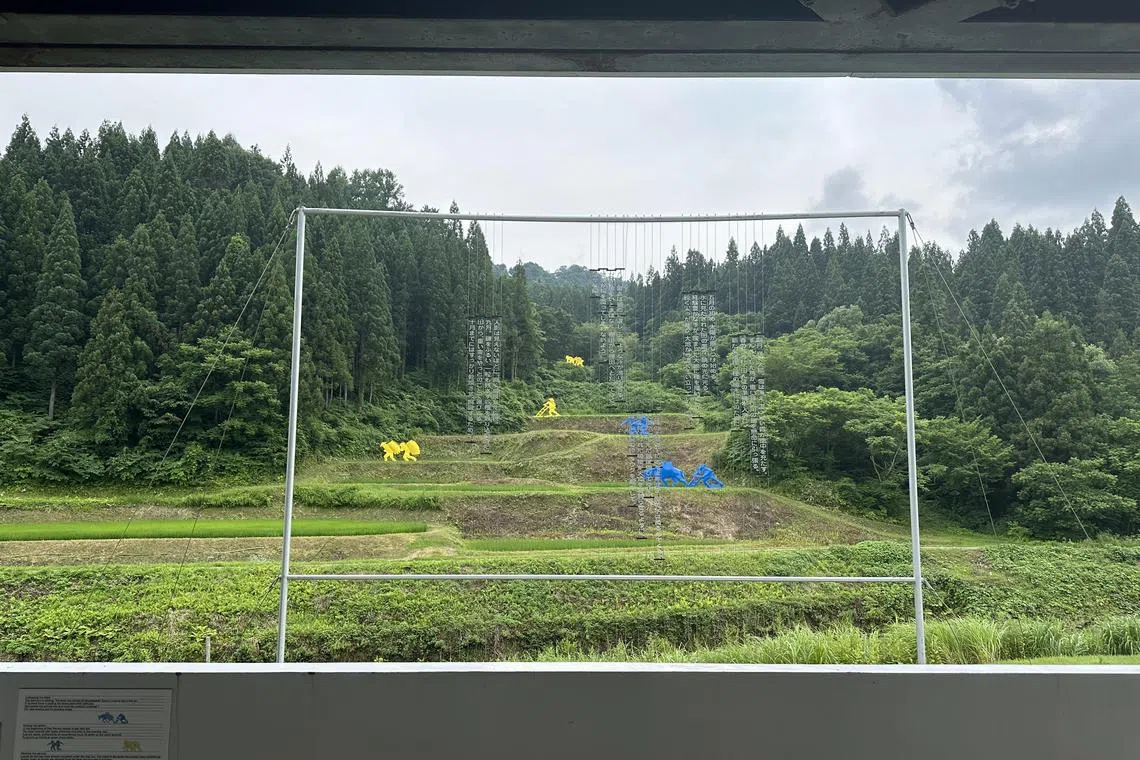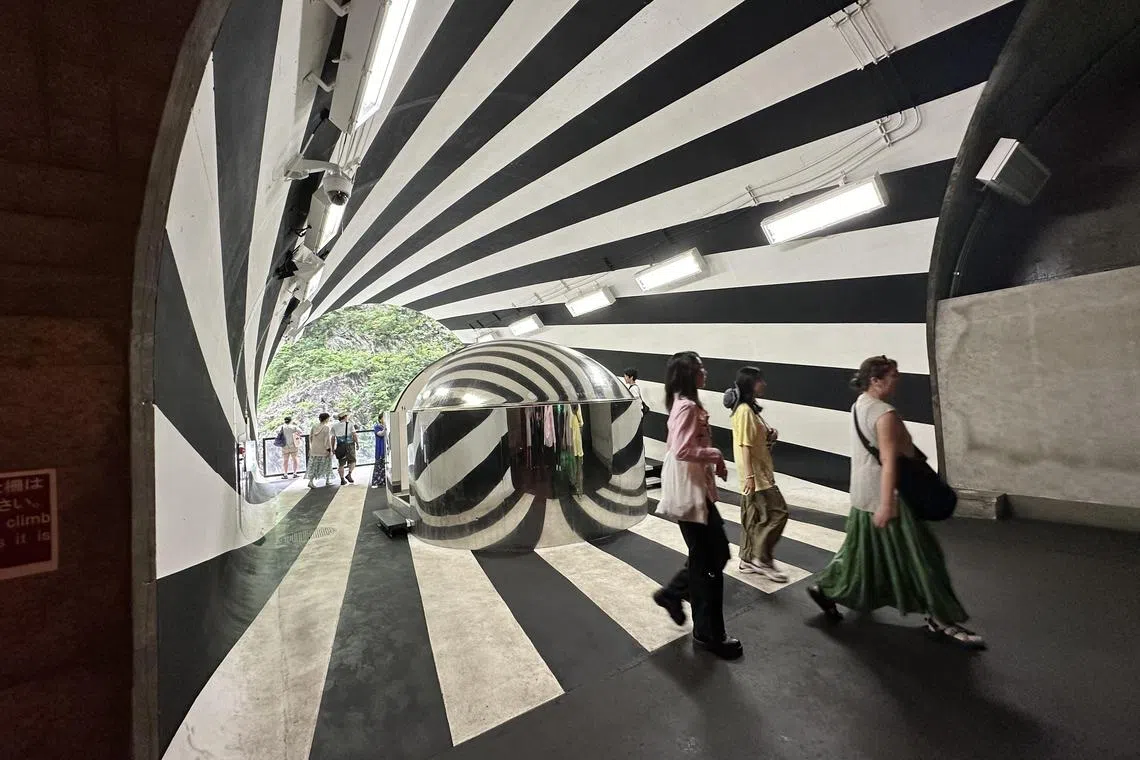How contemporary art is bringing life back to Niigata’s rural areas
Sign up now: Get ST's newsletters delivered to your inbox

The Rice Fields by Ilya and Emilia Kabakov frames colourful minimalist sculptures of farmers on a terraced hillside of working padi fields.
ST PHOTO: ONG SOR FERN
Follow topic:
NIIGATA – Farming is literally an art form in the predominantly rural prefecture of Niigata in Japan.
At the Matsudai Nohbutai Field Museum, The Rice Fields, created by renowned Russian-Jewish conceptual artist Ilya Kabakov and his wife Emilia, stacks colourful minimalist sculptures of farmers at work on a terraced hillside. It is also a functional rice field.
The installation is best viewed from the museum’s second floor, where a steel frame strung with poems framing each of the five sculptures celebrates the labour of farmers.
The field museum sprawls over 2 sq km and houses about 40 works, including a sculpture by artist Yayoi Kusama.
The museum is just one institution administered by the NPO Echigo-Tsumari Satoyama Collaborative Organization, which takes care of artworks and facilities born of the 24-year-old Echigo-Tsumari Art Triennale. The latest edition of the art show opened on July 13 and will run till Nov 10.
The NPO also oversees a riot of programmes and businesses that have mushroomed over the years, thanks to the success of the Triennale which was conceived with the purpose of reviving rural communities suffering from an ageing demographic and severe depopulation.
One side effect of the NPO’s wide-ranging remit is that it produces some 10 tonnes of rice a year, says Ms Tomoko Yamaguchi, an NPO staffer who helps harvest rice in summer and pitches in to clear snow from rooftops in the winter.
The Echigo-Tsumari region, which regularly receives two to three metres of snow over its five-month cold season, is known as “snow country”.
The rice is sold as grain at the museum shops and some is made into sake, which the prefecture is famous for.
Niigata’s success with using contemporary art as a tool for revitalising communities holds instructive lessons even for cosmopolitan urban Singapore, which has its fair share of contemporary art events and aspirations, as well as struggles with activating urban spaces.
The 18-year-old Singapore Biennale, for example, sometimes programmes contemporary art that looks forbiddingly abstract to the man on the street. The Echigo-Tsumari Art Triennale, with its social purpose firmly in mind, commissions artists on a brief that ties artworks to the local context.
Ms Yamaguchi points to Cuban artist Carlos Garaicoa’s Fuyu as an example of this approach. In the installation, a snow storm is generated with “snowflakes” made of tiny paper cutouts of houses from the Echigo-Tsumari region as well as monuments from other countries.
Created just after the devastating 2011 Tohoku earthquake, Ms Yamaguchi says the work “describes the beauty of buildings and their transience”.
She adds that artists are asked to draw on “local history, culture, industry, technology, food and memories of the people”.
The NPO also focuses on buy-in from the communities it serves. Ms Yamaguchi says the NPO creates 100 part-time jobs for the region every year, and when the Triennale is in full swing, the number climbs to 400.
She adds: “One of our aims is to increase the number of employees to revitalise the community. In the local area, the main jobs are for office workers and civil engineering. When we have various programmes, there are other careers such as tour guides or in F&B, retail and hospitality.”
The numbers attest to the Triennale’s economic and social impact. It started in 2000 with 28 villages hosting artworks and events which attracted 162,000 visitors. By 2018, the number of participating villages had grown to 102, clocking up 548,380 visitors. According to a World Economic Forum report, the 2018 edition also generated about 6.5 billion yen (S$57 million) in profit.
While there were experimental collaborations in Singapore between the arts and tourism industries during the Covid-19 pandemic lockdown, these have petered out post-pandemic as borders reopened and the industries returned to business as usual. The Triennale shows how sustained collaboration can pay off in the long run.
Some of the Triennale’s commissioned artworks have become permanent installations and attractions in their own right.
For example, visitors can book a stay in American artist James Turrell’s House Of Light (2000) a la the more famous Benesse House Museum on Naoshima island.
Despite the fact that the House Of Light is not a conventional hotel – there are no services at the building, which is situated in a forest, and visitors are advised to shop for groceries before arriving – it is popular and often fully booked months in advance. The need to operate and maintain such facilities all year round creates jobs.
It is not just the ageing population that benefits from the tourism. Old and sometimes abandoned buildings, such as houses and schools, have also been refurbished as accommodation and other facilities.
Ancillary industries in the region are boosted by tourism too. Cafe-restaurant Ikote, which opened in Tokamachi city in 2015, is housed in a quaint igloo-style wood building inspired by kamakura, the snow huts characteristic of snow country.
On the second floor, Ikote hosts activities such as a sasadango-making workshop with Madam Sato Haruno. Sasadango is a mugwort-flavoured mochi treat stuffed with anko (red bean paste) that is wrapped in bamboo leaves and steamed.

Madam Sato Haruno teaching traditional recipes to tourists at cafe-restaurant Ikote.
ST PHOTO: ONG SOR FERN
Madam Haruno, a cheerful and chatty 77-year-old who used to cook school meals, is a tiny dynamo, sharing tidbits about her daily farm routine and how she played badminton and baseball as a child.
She says via a translator that she loves to teach cooking as it keeps traditional recipes alive.
Residents in the area have found new pride in their traditions and ways of life thanks to the Triennale. The Kabakovs said in a 2018 interview with Russian media that they had received a note from the people of Echigo-Tsumari thanking them for The Rice Fields that read: “Dear Mr and Mrs Kabakov, we are so grateful (for you). No one has ever expressed us in such a vibrant manner to date.”
This combination of contemporary art and community engagement is evidently a winning formula for tourism. The WEF report noted that 40 per cent of visitors return.
More importantly, the economic revival and artistic engagement has energised the people. Ms Yamaguchi says: “The Triennale is important for local people because it encourages them to live. The starting point focused on helping local people regain pride.
“For example, the padi fields take really hard work to cultivate. But the Kabakovs celebrated their effort so they regain their pride There was a 65-year-old farmer who thought he would quit farming. But, thanks to the artwork, he continued till 85.”
The writer was hosted by the Niigata Prefecture Tourism Association.
Three must-see works at the Echigo-Tsumari Art Field
1. Invisible Bubble

The toilet at Kiyotsu Gorge is also an eye-popping installation.
ST PHOTO: ONG SOR FERN
Kiyotsu Gorge by MAD Architects
Koide, Tokamachi, Niigata 949-8433
Open: April 1 to November, 9am to 4pm daily
Admission: 1,000 yen for adults, 400 yen for children.
Everyone goes to Kiyotsu Gorge for the Light Cave. But before you get to that Instagrammable spot, you will encounter Invisible Bubble, a reflective metal structure set in the slightly trippy black-and-white striped Flow.
The Bubble is actually two functional toilets and you can look out at the heaving crowds from inside. They, on the other hand, cannot look in.
2. LOST #6 by Ryota Kuwakubo
Museum On Echigo-Tsumari (MonET)
2-71-1-6 Honcho Tokamachi-city, Niigata
Open: Till Nov 10, Thursdays to Mondays, 10am to 6pm. From Nov 11, Thursdays to Mondays, 10am to 5pm
Admission: 1,000 yen for adults, 500 yen for children. Additional fees apply for special exhibitions. Visitors can also purchase Etat 2024 Passports (4,500 yen for adults, 2,000 yen for those aged six to 18), which offers access to more than 300 artworks for the duration of the Triennale.
This dreamily fantastical installation features a model train outfitted with a lamp which travels through an array of objects that cast shadows on the walls. It is a wonderfully analogue work that engages the viewer’s attention and imagination at the same time.
One can see the very mundane objects placed precisely on the floor. Yet, once the train moves through them, they are transformed into magical shadows that create vivid landscapes.
3. White Clothes. Memories Of The Future. By Tanya Badanina
Museum On Echigo-Tsumari (MonET)
2-71-1-6 Honcho Tokamachi-city, Niigata
Open: Till Nov 10, Thursdays to Mondays, 10am to 6pm. From Nov 11, Thursdays to Mondays, 10am to 5pm
This striking installation fills a double-storey wall in the museum. Russian artist Tanya Badanina has recreated traditional Niigata farmwear in origami paper. Each outfit is hung on bamboo poles in the way expensive kimonos are usually displayed, according each a status and dignity seldom associated with humble daily wear. By placing such ordinary clothing in the spotlight, the artist pays tribute to the craft and efforts of labourers.
How to get to Niigata
Niigata is about 2½ hours by shinkansen from Tokyo. There are multiple bullet train services in the day. Tickets start at 12,960 yen for a one-way ticket for unreserved seats. For a cheaper option, get the JR East Rail Pass, which costs 27,000 yen and is valid for five consecutive days.
There are bus and train services in Niigata, but art lovers intent on seeing as many of the far-flung works as possible should consider either self-driving or hiring the services of a driver and guide. The latter will be useful as Niigata is not as cosmopolitan as the big cities and a translator will come in very handy.
Singapore-based boutique travel agency Uniq Luxe can build personalised itineraries for a minimum spend of $1,000 a day for two people. Go to uniqluxe.com
Correction note: The start date of the Triennale and the spelling of Madam Sato Haruno’s name have been corrected in this version of the story.


